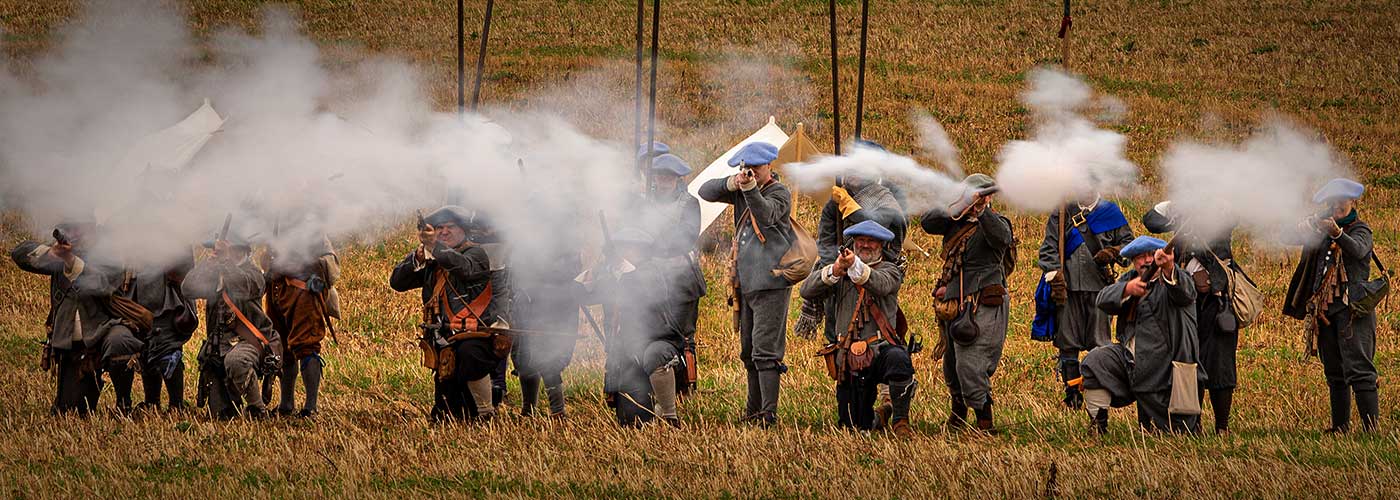Photo above used with permission by Rusty Aldwinckle www.mistresswinckle.co.uk
About the Battle of Dunbar provided by Dr. Arran Johnston of Scottish Battlefields Trust, for more information about the battle you can purchase Arran’s book: Essential Agony. The Battle of Dunbar 1650. Warwick, England. Helion and Company, 2019.
“Civil wars had raged across the British Isles since 1639, as religious and political disputes erupted into violence across the three Stuart kingdoms of Scotland, England and Ireland. During that time, Scotland was governed by the Covenanters, a nationwide movement of those subscribing to a National Covenant to protect the Presbyterian church from royal interference. From 1643, the Covenanters had been allied to the English Parliamentarians in their successful war against King Charles I. At the end of the war, however, relations between the allies were strained. In 1649 the English parliament executed the king – who was himself a Scotsman – without the consent of the Scottish parliament. The latter therefore acknowledged the right of the dead king’s son to reign as King Charles II. After complicated negotiations, the young king was invited to Scotland on the condition that he signed the National Covenant and acted merely as a figurehead for the Covenanter government.
The English parliament had meanwhile abolished the monarchy, and to prevent the king’s presence in Scotland becoming a rallying point for royalism, they invaded Scotland in the summer of 1650. They sent an experienced army under the command of Oliver Cromwell, lately returned from victories in Ireland. The Scots raised a large but hastily assembled army in response, blocking Cromwell’s approach to Edinburgh and forcing him to retreat to the small harbour town of Dunbar. Commanded by the veteran soldier David Leslie, the Scottish army pursued the English and successfully bottled them up around Dunbar, threatening to cut them off from both advance and retreat. On 1 September the Scots occupied a powerful position on the heights of Doon Hill, but on the hilltop the soldiers were exposed to the terrible weather and so on 2 September they moved to a lower position fronted by a steep-sided ravine. Their right flank (nearest the sea) controlled the road to England, Cromwell’s only escape route. The rain continued to pour, making the ground muddy and the soldiers miserable. But the Scottish army could be confident that it had an advantage of numbers, and that Cromwell’s army had been further reduced by sickness.
During the night, however, Cromwell planned to break out of the trap by concentrating all his forces in one powerful push against the Scots’ right flank. He planned to use his veteran-heavy cavalry to smash through the Scottish horsemen and gain control of the road. Then he could decide whether to continue fighting or just force an escape. The attack was launched just as the rain stopped at around 5am on 3 September. The Cromwellian army caught the Scots completely by surprise, smashing into their flank and rolling it back. As the Scots reeled from the shock, Cromwell sensed the advantage and determined to destroy the Scottish army whilst he had the chance. After the Scottish horsemen were beaten back, Cromwell’s cavalry were able to sweep around the flank and rear of the Scottish foot-soldiers. These infantry divisions found it difficult to redeploy because they were constrained by the landscape, with the ravine in front and Doon Hill behind. As one end of the Scottish line crumbled, the stream of fugitives disrupted the rest and soon the whole battle-line collapsed. The Cromwellian cavalry exploited the disorder, cutting groups of soldiers off from retreat and forcing them to surrender rather than perish. The pursuit continued for eight miles.
Between 2,000-3,000 Scottish soldiers were slain in the rout, and thousands more taken prisoner. For the latter, the Battle of Dunbar was only the beginning of their trials. Cromwell had rescued his army from the brink of disaster, but the campaign had been exhausting and the war was far from over. David Leslie and most of the Scottish cavalry had escaped.”




